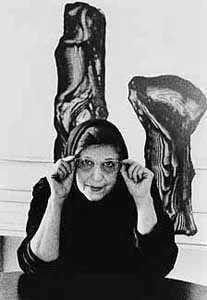Behjat Sadr facts for kids
Quick facts for kids
Behjat Sadr
|
|
|---|---|
 |
|
| Born |
Behjat Sadr Mahallāti
29 May 1924 Arak, Iran
|
| Died | 10 August 2009 (aged 85) |
| Nationality | Iranian French |
| Education | University of Tehran |
| Known for | Painting |
| Movement | Abstraction |
| Spouse(s) | Morteza Hannaneh |
Behjat Sadr (Persian: بهجت صدر, born May 29, 1924 – died August 10, 2009) was a famous Iranian modern artist. Her paintings have been shown in big cities like New York, Paris, and Rome. She was known for using a special tool called a palette knife to create cool shapes and movement in her art. She often painted on canvases or metal surfaces.
Contents
About Her Life
Behjat Sadr Mahallāti was born in Arak, Iran, on May 29, 1924. Her parents were Mohammad Sadr Mahallāti and Qamar Amini Sadr.
Early Education and Art Studies
After studying at the Faculty of Fine Arts at the University of Tehran, Behjat won a special scholarship. This allowed her to travel to Italy. There, she continued her art studies at the Accademia di Belle Arti di Roma in Rome and the Accademia di Belle Arti di Napoli in Naples.
Becoming an Abstract Artist
Soon after she arrived in Rome, Behjat changed her painting style. She moved away from traditional academic painting. Instead, she started creating abstract art. Abstract art uses shapes, colors, and lines instead of showing things exactly as they look.
Her first big art show was at the Gallery La Bussola in Rome in 1958. A year before, in 1956, she had shown her work at the twenty-eighth Venice Biennial. This is a very important art event in Venice, Italy. She even won second prize at San Vito Romano.
While in Rome, she became good friends with the Persian poet Forough Farrokhzad. Forough had actually been one of Behjat's students in Tehran. In Rome, Behjat also met her second husband, Morteza Hannaneh, who was a Persian composer. They got married in 1975 and had one child, a daughter named Kakuti (Mitra) Hannaneh.
Returning to Iran
In 1957, Behjat Sadr decided to go back to Iran. She became a professor at the University of Tehran. Even though she had chances to keep painting in Rome and Paris, she chose to teach. She taught art in Tehran for almost 20 years.
International Recognition
Behjat Sadr won the Royal Grand Prize at the Tehran Biennial in 1962. She also took part in many international art events. These included the Venice Biennial and the Sao Paulo Biennial. She had many solo and group art shows. She spent two years in Paris for her art in 1968 and again in 1975.
In 1980, Behjat and her daughter moved to Paris. This was one year after the Islamic Revolution in Iran.
Her Later Life and Impact
Behjat Sadr was diagnosed with breast cancer in the 1980s. But she kept painting and creating art. She passed away from a heart attack on August 10, 2009, when she was 85 years old. She was swimming in Corsica, France, at the time. She had often written about wanting to die in the sea.
Behjat Sadr was a very important artist. She was the first female modern painter in Iran to be seen as equally talented as her male artist friends.
In 2006, a documentary film was made about her. It was called Behjat Sadr: Time Suspended. The film was directed by Mitra Farahani. It showed Behjat working on her art and included many interviews with her.
Group Exhibitions
- 1956: Venice Biennial, Venice, Italy
- 1957: Venice Biennial, Venice, Italy
- 1957: Galleria Il Pincio, Rome, Italy
- 1962: Venice Biennial, Venice, Italy
- 1962: The 3rd Tehran Painting Biennial, Tehran, Iran
- 1962: São Paulo Biennial, São Paulo, Brazil
- 1987: Iranian Contemporary Art: Four Women, Foxley Leach Gallery, Washington DC
See also
- List of Iranian women artists
Images for kids


